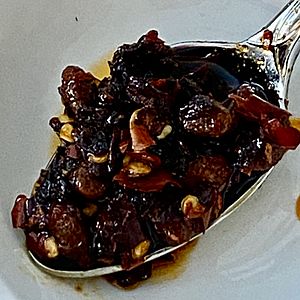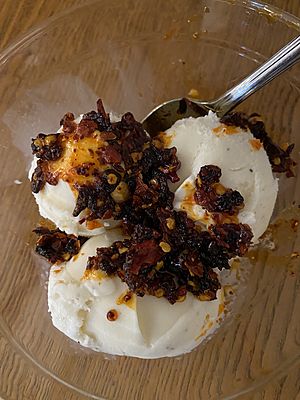Chili crisp facts for kids
 |
|
| Place of origin | China |
|---|---|
| Main ingredients | chili pepper, soybean oil |
Chili crisp or chile crisp is a super tasty hot sauce from China. It's made with crispy fried chili peppers and other yummy flavors mixed in oil. Sometimes it has other ingredients too. Many families and restaurants in China make their own special versions. The most famous brand you might know is Lao Gan Ma. It comes from Guizhou province in China.
Contents
The Story of Chili Crisp
People in China have been making hot sauces with oil for hundreds of years. Different parts of China developed their own ways to make it. In southern China, they often cook the ingredients in the oil slowly. In northern China, they usually pour hot oil over the ingredients. Almost every restaurant in China has its own unique recipe!
In 1997, a Chinese restaurant owner named Tao Huabi started selling chili crisp in jars. Her brand, Lao Gan Ma, quickly became very popular in China. It became a common item in Chinese kitchens. Chili crisp wasn't well-known around the world until the late 2010s. It became especially popular in the US during the coronavirus pandemic. Many people found it a must-have for cooking at home.
What's in Chili Crisp?
Chili crisp is a sauce that has lots of crunchy bits. These bits are usually pieces of chili pepper. It also has other spices like garlic, onions, or scallions. It's related to chili oil and chili sauce. Sometimes, people use these names to mean the same thing.
But chili crisp is special because it has way more crunchy pieces than oil. This gives it its unique texture. You usually spoon it onto food, not pour it. You add it to dishes right before you eat them. It's not typically used for cooking while the food is on the stove.
Common Ingredients
A traditional ingredient often found in chili crisp is Sichuan pepper. This pepper adds a special tingle. The oil base is usually Rapeseed oil or soybean oil. Unlike many hot sauces, chili crisp does not use vinegar.
The Amazing Flavor of Chili Crisp
Chili crisp tastes savory, salty, spicy, and oily all at once. It's like a "flavor bomb" that is very rich and full of umami. Umami is a special savory taste, like in mushrooms or cheese. Some people describe the flavor as having the satisfying crunch of potato chips. It also has a perfect amount of tingling chili heat.
If chili crisp has Sichuan pepper, it can create a feeling called ma-la. This means an "intense heat and numbing sensation." This feeling is often found in foods from the Sichuan region of China. Besides the great taste, many people love chili crisp for its interesting crunchy texture.
How to Use Chili Crisp
People say chili crisp is good with "anything" and "everything." This even includes desserts! Chef Sam Sifton called it "magical." He said it can make any food taste better. It's usually used as a topping, not something you cook with.
You can put it on many different dishes. Try it on avocado toast, tacos, eggs, fish, or vegetables. It's also great on salads, fruit, or grains. Some people even put it on peanut brittle or vanilla ice cream. You can stir it into soups or noodles. It also works well as a dip or a spread.
Topping ice cream with chili crisp is an example of hei an liao li. This Chinese internet term means "dark cuisine." It refers to unusual or surprising food combinations.
How Chili Crisp is Made
There are different ways to make chili crisp. Some people simmer the ingredients in oil. Others pour hot oil over the ingredients. To make the crunchy bits extra crispy, ingredients like onions are sometimes cooked separately first. This helps remove their water.
Chili crisp is also made in places like Taiwan, Japan, and Mexico. These versions often use local ingredients. For example, they might use árbol chiles or sesame seeds.


